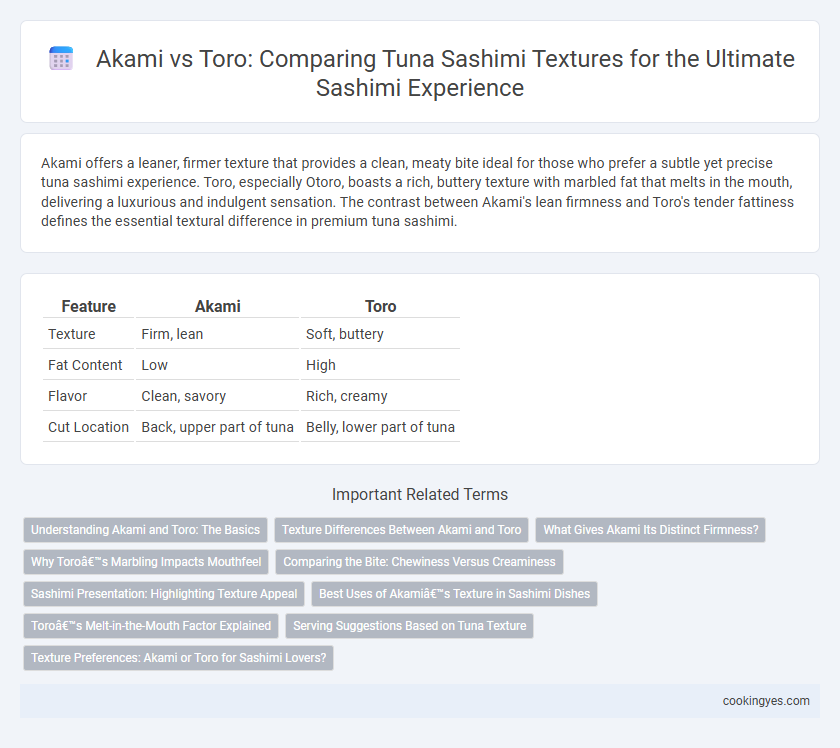Akami offers a leaner, firmer texture that provides a clean, meaty bite ideal for those who prefer a subtle yet precise tuna sashimi experience. Toro, especially Otoro, boasts a rich, buttery texture with marbled fat that melts in the mouth, delivering a luxurious and indulgent sensation. The contrast between Akami's lean firmness and Toro's tender fattiness defines the essential textural difference in premium tuna sashimi.
Table of Comparison
| Feature | Akami | Toro |
|---|---|---|
| Texture | Firm, lean | Soft, buttery |
| Fat Content | Low | High |
| Flavor | Clean, savory | Rich, creamy |
| Cut Location | Back, upper part of tuna | Belly, lower part of tuna |
Understanding Akami and Toro: The Basics
Akami is the lean, red muscle from the sides of the tuna, prized for its firm texture and clean, slightly metallic flavor ideal for sashimi. Toro, found in the fatty belly section, is divided into Chutoro and Otoro, offering a buttery, melt-in-the-mouth experience due to its higher fat content. The contrast between Akami's lean firmness and Toro's rich, creamy texture defines the diverse appeal of tuna sashimi.
Texture Differences Between Akami and Toro
Akami, the leaner cut of tuna, features a firm and meaty texture that offers a clean, slightly chewy bite ideal for those who prefer a less fatty sashimi experience. Toro, prized for its high fat content, is buttery and tender, melting smoothly in the mouth with a rich, creamy texture that contrasts sharply with the denseness of Akami. These distinct texture differences between Akami and Toro make each uniquely appealing depending on whether a diner seeks a lean, robust chew or a soft, melt-in-your-mouth sensation.
What Gives Akami Its Distinct Firmness?
Akami's distinct firmness in tuna sashimi results from its low-fat content and dense muscle fibers compared to Toro, which is richer in fat and softer. The lean nature of Akami contributes to a more resilient texture, allowing for cleaner cuts and a satisfying bite. This muscle composition, combined with careful slicing techniques, enhances the textural contrast prized in traditional sashimi dining.
Why Toro’s Marbling Impacts Mouthfeel
Toro's marbling in tuna sashimi creates a rich, buttery texture that melts in the mouth, offering a smooth and velvety mouthfeel compared to the firmer, leaner Akami. The high fat content in Toro influences its softness and enhances juiciness, providing a luxurious eating experience. This marbling contributes to a tender consistency that contrasts with Akami's muscle fibers, which are denser and less fatty.
Comparing the Bite: Chewiness Versus Creaminess
Akami, known for its lean muscle, offers a firm yet tender bite characterized by a satisfying chewiness that highlights the clean, rich flavor of tuna. Toro, especially Otoro, delivers a buttery, melt-in-the-mouth creaminess with higher fat content, creating a luscious texture that contrasts sharply with the firmer Akami. The distinction in bite between Akami's chewiness and Toro's creaminess reflects their differing fat marbling, making each cut a unique sensory experience in tuna sashimi.
Sashimi Presentation: Highlighting Texture Appeal
Akami offers a firm, lean texture with a clean bite, providing a visually striking deep red hue that enhances sashimi presentation through its vibrant color contrast. Toro, known for its rich marbling and buttery softness, presents a delicate melt-in-the-mouth texture that elevates the sashimi's luxurious appeal with its pale pink and white streaks. The interplay of Akami's crisp firmness and Toro's smooth richness creates a dynamic textural experience that highlights the craftsmanship of tuna sashimi presentation.
Best Uses of Akami’s Texture in Sashimi Dishes
Akami, the leaner part of the tuna, offers a firm and slightly fibrous texture ideal for sashimi dishes that emphasize clean, crisp bites such as nigiri or simple sashimi platters. Its dense muscle fibers hold shape well, making it perfect for precise cuts and presentations where texture contrast with softer components is desired. Chefs often use Akami in sashimi to balance the rich, buttery texture of Toro, providing a refreshing, meaty mouthfeel that highlights the tuna's natural flavors.
Toro’s Melt-in-the-Mouth Factor Explained
Toro, the fatty belly portion of tuna, offers a rich, buttery texture that melts effortlessly in the mouth due to its high fat content, making it highly prized in sashimi cuisine. In contrast, Akami, the leaner, red muscle meat, delivers a firmer, more fibrous texture with a clean, savory flavor. The melt-in-the-mouth factor of Toro is attributed to its marbling, which provides a smooth, velvety sensation that enhances the overall sashimi experience.
Serving Suggestions Based on Tuna Texture
Akami, the lean red meat from the tuna's back, offers a firm and slightly chewy texture ideal for sashimi served thinly sliced to highlight its clean taste and muscle grain. Toro, rich in fat from the belly, provides a buttery, melt-in-the-mouth texture best enjoyed in thicker slices or lightly seared to emphasize its creamy richness. Serving Akami with sharp condiments like wasabi and soy sauce complements its robust texture, while Toro pairs well with lighter dipping sauces or a touch of citrus to balance its fatty smoothness.
Texture Preferences: Akami or Toro for Sashimi Lovers?
Akami offers a firm, lean texture with a clean bite, favored by sashimi lovers who prefer a more robust and less fatty experience. Toro, on the other hand, boasts a buttery, melt-in-the-mouth texture due to its higher fat content, appealing to those seeking a rich and silky sashimi indulgence. Texture preferences often depend on the balance between the satisfying chew of Akami and the luxurious softness of Toro.
Akami vs Toro for Tuna Sashimi Texture Infographic

 cookingyes.com
cookingyes.com